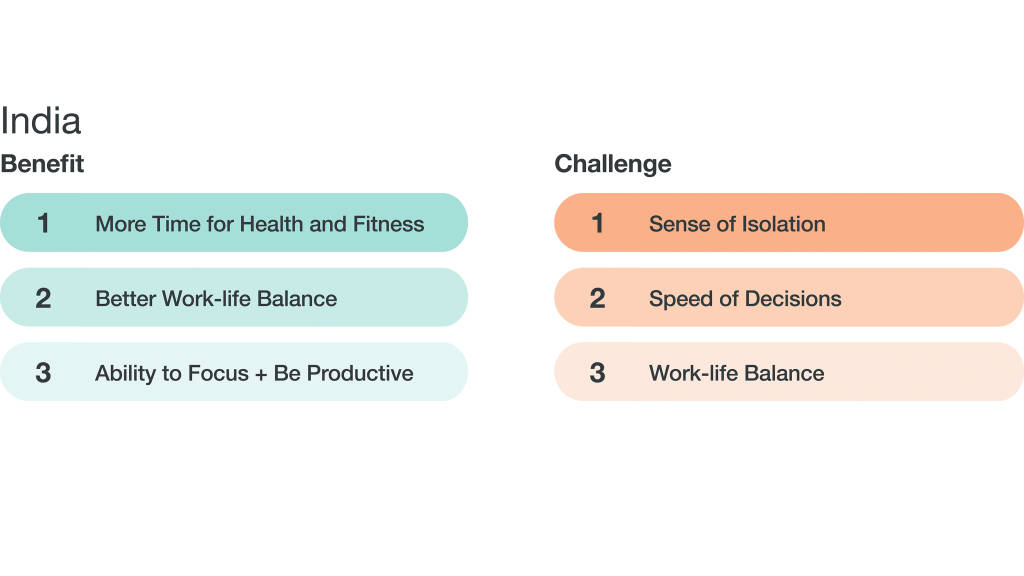Why India’s Gen Z Can’t Wait to Get Back to the Office
Working from home might be a dream for some, but not India’s Generation Z. After a year and a half, these digital natives are itching to return to the office and move their careers forward.
India is home to the largest Generation Z population in the world, with roughly 472 million individuals born between 1997 and 2012. Not only is this cohort substantial in size — representing 34.5 percent of the country’s 1.3 billion population — but it’s also the most tech-savvy.
These digital natives will undoubtedly transform India’s business landscape and accelerate innovation in the years to come, but in the meantime, they’re stuck in neutral.
In 2020, many Gen Z (currently between six and 25 years old) were still finding their footing in a first or second job. Then came the COVID-19 pandemic, which caused companies across India to shutter offices, leaving young employees feeling isolated, rudderless and, at times, distracted while working remotely. After over a year of working from home, India’s youngest employees are ready to return to the office and get their careers in motion.
“Interestingly, even though Gen Z is so digitally adept, they are suffering the most during these times since they really crave face-to-face collaboration,” said Praveen Rawal, Managing Director of Steelcase India. “They thrive when they have many opportunities for teamwork and feel a sense of community. I’ve noticed that our Gen Z employees make an attempt to get out and about, when it’s safe, and generate meaningful connections.”
A temporary setback
Aparna Kuttikat, 22, is an assistant manager of brand communications and fashion content for Projekt Indigo, a platform for sustainable denim brands in Karnataka, Bangalore. After graduating in 2020 during the pandemic, she got her first job then moved into her current position, working remotely during India’s catastrophic second wave. She says working from home has been very challenging, especially when it comes to much-needed FaceTime with her colleagues.
“I feel like meeting people in person and being able to have open discussions helps us newer employees understand unfamiliar perspectives, especially for those working in the creative space,” she says.
Ann Mary Tom, 22, a copywriter at Dentsu Webchutney, a creative agency in Kerala, agrees. Tom, who started her first job in September 2020, says that there are undeniable perks to working from home — like more personal time and fewer distractions — but she’d much prefer to work in an office.
“A huge part of a job is the routine that comes with it — the people you meet every day, the choices you make about how you dress or where to eat lunch,” says Tom. “Too much is missing from our day when we work remotely, and I consider this whole scenario as a temporary setback. I wouldn’t want this as a permanent reality.”
Kuttikat also worries that the extended break from an office could hamper her professional development, as well as that of her peers, by denying them precious opportunities to learn, network, communicate and collaborate with colleagues and supervisors in person.
“We often don’t know how to talk to someone at a higher position professionally, make a point in a meeting, or accept constructive criticism,” Tom observes, reflecting on skills that typically form through exposure and practise.
According to Steelcase’s recent “Global Report: Changing Expectations and the Future of Work”, which surveyed more than 32,000 people across 10 countries, employee needs are indeed changing.
While there are many perks of working from home, employees across the board ranked “isolation” and “engagement” as two of the leading concerns about working remotely. In India, specifically, the “sense of isolation” was the primary challenge, followed closely by “speed of decisions” and “work-life balance.”

“An element of the fulfillment you get through community is a sense of belonging — feeling connected, united and accepted by your people. But a sense of belonging doesn’t just come from being in a group, it arises from a shared sense of social identity,” writes Tracy Brower, an environmental sociologist, author and Principal with Steelcase Applied Research + Consulting group, in a recent Forbes article.
“In our modern work, we crave connections, and these are often most rewarding when we’re in the trenches with co-workers developing the bid for the customer or working through the issue that crops up with the new product launch. Solving problems and using our talents are sources of happiness and fulfillment.”
DR. TRACY BROWERPrincipal At Steelcase Applied Research + Consulting
Striking the right balance
Following COVID-19 remote work arrangements, companies in India reported a 16 percent drop in engagement among office workers and a 7 percent drop in productivity, according to Steelcase’s 2021 Global Report: Changing Expectations and The Future of Work, which surveyed 32,000 office workers and business leaders around the world.
These numbers reflect a complicated reality for India’s Gen Z, many of whom share their remote workspace with family.
“It’s a very different lifestyle in India; you have to contribute to the house when you’re at home all day,” says Ryan Gonsalves, a 25-year-old who has worked for Under25, a Bengaluru media and entertainment startup, since May 2019. “You have to pitch in. All this while you’re working and dealing with your family… you’re often caught between tasks.”
A better work-life balance is something that more employees in India — particularly younger, more progressive teammates — are keen to implement. And according to Steelcase’s recent article, “Hybrid Collaboration is Hard,” which outlines insights to improve in-person and virtual productivity, this follows current global trends with 68% of organizations worldwide saying they plan to experiment with hybrid work models.
“I would definitely like to go back to the workplace,” says Tom. “However, I think a hybrid workweek would be best for me.”
Both Kuttikat and Gonsalves say they would welcome a more flexible schedule that enables a mix of office and remote work. This aligns with Steelcase’s findings on post-pandemic worker expectations, which found that people in India expect to work from home more often than workers in other countries surveyed. In fact, 39 percent of employees in India expect to work remotely for one day a week or less; 35 percent, two to three days; and 27 percent, four to five days.
“Maybe employers can be a little more understanding about when and where people work,” says Gonsalves. “We should adjust to people’s individual needs. As long as you get the work done, attend meetings, and own your role and responsibility — then more flexibility should be totally okay.”


